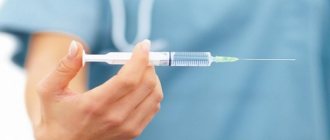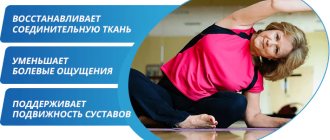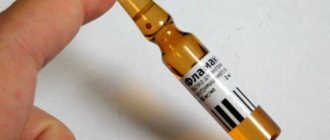For the treatment of joint and muscle pain, as well as sprains and osteoarthritis, the effective remedy “Artrosilene” is used. It contains ketoprofen in an easily digestible form. The medicine relieves pain well, prevents inflammation, and relieves swelling. Used to treat adults and children over 6 years of age.
Nosological classification (ICD-10)
- L40.5 Arthropathic psoriasis (M07.0-M07.3*, M09.0*)
- M06.9 Rheumatoid arthritis, unspecified
- M10 Gout
- M35 Other systemic connective tissue disorders
- M42 Osteochondrosis of the spine
- M45 Ankylosing spondylitis
- M65 Synovitis and tenosynovitis
- M71 Other bursopathies
- M77.9 Enthesopathy, unspecified
- M79.0 Rheumatism, unspecified
- M79.1 Myalgia
- M79.9 Soft tissue disease, unspecified
- R52.0 Acute pain
- R52.2 Other persistent pain
- T14.9 Injury, unspecified
- Z100* CLASS XXII Surgical practice
Composition and release form
| Capsules | 1 caps. |
| ketoprofen lysine salt | 320 mg |
| excipients: diethyl phthalate - 2.286 mg; carboxypolymethylene - 32.857 mg; magnesium stearate - 15.857; povidone - 27.857; polymers of acrylic and methacrylic acid - 34.143; talc - 27 mg | |
| shell: body - titanium dioxide (E171), gelatin qsp; lid - quinoline yellow (E104); indigotine (E132); titanium dioxide (E171); gelatin qsp |
10 pcs in blister; 1 blister in a cardboard pack.
| Solution for intravenous and intramuscular administration | 1 ml |
| ketoprofen lysine salt | 80 mg |
| excipients: sodium hydroxide; citric acid; water for injections |
in dark glass ampoules of 2 ml; 6 pcs in a pallet, 1 pallet in a cardboard pack.
| Suppositories for rectal use | 1 sup. |
| ketoprofen lysine salt | 160 mg |
| excipients: semi-synthetic glycerides |
5 pcs per strip; 2 strips in a cardboard pack.
| Gel for external use 5% | 1 g |
| ketoprofen lysine salt | 50 mg |
| excipients: carboxypolymethylene; triethanolamine; polysorbate; ethyl alcohol 95%; methyl p-hydroxybenzoate; lavender/nerolen; water |
in aluminum tubes of 30 and 50 g; in a cardboard pack 1 tube.
| Aerosol for external use 15% | 1 g foam |
| ketoprofen lysine salt | 150 mg |
| excipients: polysorbate 80; polypropylene glycol; PVP (povidone); lavender/nerolen; benzyl alcohol; purified water; propellant - propane-butane |
in 25 ml cylinders with a spray nozzle; 1 cylinder in a cardboard pack.
Description of the dosage form
Capsules: oblong hard gelatin capsules; the body is white, the lid is dark green. The contents of the capsule are round granules from white to light yellow.
Solution for intravenous and intramuscular administration: transparent, colorless or slightly yellowish solution.
Rectal suppositories: homogeneous, from white to light yellow, torpedo-shaped.
Gel: transparent, thick, with the smell of lavender.
Aerosol: white homogeneous foam; after the gas escapes, it is a clear, pale yellow liquid.
Pharmacodynamics
It has anti-inflammatory, analgesic and antipyretic effects. By inhibiting COX-1 and -2, it inhibits the synthesis of PG. It has anti-bradykinin activity, stabilizes lysosomal membranes and delays the release of enzymes from them that contribute to tissue destruction during chronic inflammation. Reduces the release of cytokines, inhibits the activity of neutrophils.
Reduces morning stiffness and swelling of joints, increases range of motion.
Ketoprofen lysine salt, unlike ketoprofen, is a rapidly soluble molecule with a neutral pH and is almost non-irritating to the gastrointestinal tract.
When applied topically, it has local anti-inflammatory, antiexudative and analgesic effects. In the form of a spray or gel, it provides a local therapeutic effect on affected joints, tendons, ligaments, and muscles. In case of articular syndrome, it causes a decrease in joint pain at rest and during movement, a decrease in morning stiffness and swelling of the joints. The lysine salt of ketoprofen does not have a catabolic effect on articular cartilage.
Pharmacokinetics
Capsules
Suction. When administered orally, ketoprofen is quite completely absorbed from the gastrointestinal tract, and its bioavailability exceeds 80%. Cmax in plasma when taking Artrosilene capsules is observed 4–10 hours after oral administration, its value directly depends on the dose taken and is 3–9 μg/ml. T1/2 is 6.5 hours. The maximum therapeutic effect is observed over a period of 4 to 24 hours. Food helps to reduce Cmax values and increase Tmax without changing AUC.
Distribution. Up to 99% of absorbed ketoprofen is bound to plasma proteins, mainly albumin. Vd - 0.1–0.2 l/kg. Easily penetrates histohematic barriers and is distributed in tissues and organs. Ketoprofen penetrates well into synovial fluid and connective tissue. Although the concentration of ketoprofen in synovial fluid is slightly lower than in plasma, it is more stable (lasts up to 30 hours).
Metabolism. Ketoprofen is primarily metabolized in the liver, where it undergoes glucuronidation to form esters with glucuronic acid.
Excretion. Metabolites are excreted in the urine. Less than 1% is excreted in feces. The drug does not accumulate.
Solution for intravenous and intramuscular administration
Tmax for parenteral administration is 20–30 minutes. The effective concentration lasts 24 hours. Therapeutic concentration in synovial fluid lasts 18–20 hours.
Distribution. Up to 99% of absorbed ketoprofen is bound to plasma proteins, mainly albumin. Vd - 0.1–0.2 l/kg. Easily penetrates histohematic barriers and is distributed in tissues and organs. Ketoprofen penetrates well into synovial fluid and connective tissue. Although the concentration of ketoprofen in synovial fluid is slightly lower than in plasma, it is more stable (lasts up to 30 hours).
Metabolized by microsomal liver enzymes. Excreted by the kidneys, 60–80% in the form of glucuronide in 24 hours.
Suppositories
Suction. Ketoprofen lysine salt is rapidly absorbed: Tmax after rectal administration is 45–60 minutes. The plasma concentration depends linearly on the dose taken.
Distribution. Up to 99% of absorbed ketoprofen is bound to plasma proteins, mainly albumin. Vd - 0.1–0.2 l/kg. Easily penetrates histohematic barriers and is distributed in tissues and organs. Ketoprofen penetrates well into synovial fluid and connective tissue. Although the concentration of ketoprofen in synovial fluid is slightly lower than in plasma, it is more stable (lasts up to 30 hours).
Metabolism. Ketoprofen is primarily metabolized in the liver, where it undergoes glucuronidation to form esters with glucuronic acid.
Excretion. Metabolites are excreted mainly in the urine (up to 76% after 24 hours). The drug does not accumulate.
Gel, aerosol
When applied cutaneously, it is absorbed slowly; a dose of 50–150 mg over 5–8 hours produces a plasma concentration level of 0.08–0.15 mcg/ml. Practically does not accumulate in the body. Bioavailability is about 5%.
Use during pregnancy and breastfeeding
Capsules, solution for intravenous and intramuscular administration, suppositories
Like other NSAIDs, Artrosilene should not be used in the third trimester of pregnancy. The use of the drug in the first and second trimesters should be carefully monitored by the attending physician. Breastfeeding should be discontinued while using the drug.
Gel, aerosol
Cannot be used in the third trimester of pregnancy.
There is no experience with the use of Artrosilene during lactation. Use in the first and second trimesters is possible only after consultation with a doctor.
Overdose and special instructions
The drug is safe for health if the dosage is observed. Cases of overdose have not been described to date. The composition should be applied only to undamaged parts of the skin. It is necessary to avoid contact with the surface of the eyes, as well as mucous membranes, for example, the oral cavity.
During the course of therapy, you should not be in the sun or sunbathe, including in a solarium. Infrared radiation destroys the active ingredient, which is why the therapeutic effect is reduced to zero.
The drug should be used during pregnancy, but only during the 1st and 2nd trimester. It is also prescribed to children aged 6 years and older.
Side effects
Capsules, solution for intravenous and intramuscular administration, suppositories
From the gastrointestinal tract: abdominal pain, diarrhea, stomatitis, esophagitis, gastritis, duodenitis, erosive and ulcerative lesions of the gastrointestinal tract, hematomesis, melena.
From the liver: increased bilirubin levels, increased activity of liver enzymes, hepatitis, liver failure, increased liver size
From the nervous system: dizziness, hyperkinesia, tremor, vertigo, mood swings, anxiety, hallucinations, irritability, general malaise.
From the senses: conjunctivitis, visual impairment.
From the skin: urticaria, angioedema, erythematous exanthema, itching, maculopapular exanthema, increased sweating, exudative erythema multiforme (including Stevens-Johnson syndrome).
From the genitourinary system: painful urination, cystitis, edema, hematuria, menstrual irregularities.
From the hematopoietic organs: leukocytopenia, leukocytosis, lymphangitis, decreased PV, thrombocytopenia, thrombocytopenic purpura, enlarged spleen, vasculitis.
From the respiratory system: bronchospasm, dyspnea, sensation of laryngeal spasm, laryngospasm, laryngeal edema, rhinitis.
From the cardiovascular system: hypertension, hypotension, tachycardia, chest pain, syncope, peripheral edema, pallor.
Allergic reactions: anaphylactoid reactions, swelling of the oral mucosa, pharyngeal edema, periorbital edema.
Suppositories additionally
Local reactions: burning, itching, heaviness in the anorectal area, exacerbation of hemorrhoids.
Gel, aerosol
Allergic reactions, photosensitivity.
If any adverse event occurs, you should consult a doctor.
Indications for use
The drug is indicated for use mainly for the treatment of pathologies of the musculoskeletal system, for example:
- arthritis of various natures;
- osteoarthritis;
- rheumatism of soft tissue;
- spondylitis of ankylosing type;
- muscle pain, including those not associated with rheumatism.
The drug is also indicated for use in the following cases:
- eczema;
- wounds and other injuries to the skin;
- weeping type dermatosis;
- injuries, soft tissue damage.
Interaction
Inducers of microsomal oxidation in the liver (phenytoin, ethanol, barbiturates, flumecinol, rifampicin, phenylbutazone, tricyclic antidepressants) increase the production of hydroxylated active metabolites.
Reduces the effectiveness of uricosuric drugs, enhances the effect of anticoagulants, antiplatelet agents, fibrinolytics, ethanol, side effects of mineralocorticoids, corticosteroids, estrogens; antihypertensive and diuretic drugs.
Combined use with other NSAIDs, corticosteroids, ethanol, corticotropin can lead to the formation of ulcers and the development of gastrointestinal bleeding, increasing the risk of developing renal dysfunction.
Co-administration with oral anticoagulants, heparin, thrombolytics, antiplatelet agents, cefoperazone, cefamandole and cefotetan increases the risk of bleeding.
Increases the hypoglycemic effect of insulin and oral hypoglycemic drugs (dose recalculation is necessary).
Co-administration with sodium valproate causes disruption of platelet aggregation.
Increases plasma concentrations of verapamil and nifedipine, lithium, methotrexate.
Antacids and cholestyramine reduce absorption.
Side effects
Side effects are observed infrequently, and reactions can occur from different organ systems:
- diarrhea;
- gastritis;
- ulcers on the mucous membranes of the digestive organs;
- hepatitis of various nature;
- esophagitis;
- visual impairment;
- allergic reactions;
- stomatitis;
- irritability;
- unstable mood;
- hives;
- increased sweating;
- swelling;
- cystitis;
- problems with the menstrual cycle;
- leukocytosis;
- bronchospasms;
- spasms of the larynx;
- rhinitis;
- high blood pressure;
- hives;
- discomfort when urinating;
- pale skin;
- heart rhythm disturbance;
- swelling of the oral mucosa and pharynx.
Directions for use and doses
Inside, parenterally, rectally, externally.
The drug is prescribed 1 caps orally. per day during or after meals. The duration of treatment can be 3–4 months.
IM or IV 1 amp. per day. The maximum daily dose is 1 amp. 2 times a day. IV administration of the drug is allowed only in a hospital. The drug is used for short-term treatment - up to 3 days. If further use of the drug is necessary, it is recommended to switch to oral dosage forms or suppositories. In elderly patients, use no more than 1 amp. per day.
Ampoules should be opened along a special break line. After opening the ampoule, use the solution immediately.
Aqueous solutions of ketoprofen lysine salt can be used in physiotherapeutic treatment (iontophoresis, mesotherapy); In iontophoresis, the solution is applied to the negative pole.
When administered intravenously, a slow intravenous infusion is recommended to increase the duration of action of the drug. The solution for infusion is prepared on the basis of 50 or 500 ml of the following aqueous solutions: 0.9% sodium chloride solution, 10% aqueous levulose solution, 5% aqueous dextrose solution, Ringer acetate solution, Ringer lactate solution (Hartmann), colloidal dextran solution in 0 .9% sodium chloride solution or 5% dextrose solution. When diluting Artrosilene in small volume solutions (50 ml), the drug is administered intravenously as a bolus. In large volume solutions (500 ml), the infusion duration is at least 30 minutes.
Rectally 1 sup. 2–3 times a day. The maximum daily dose is 480 mg. In elderly patients, no more than 2 supp. should be used. per day.
Externally. A single dose of gel is 3–5 g (the volume of a large cherry), an aerosol is 1–2 g (the volume of a walnut). Depending on the size of the damaged area, the drug should be applied 2-3 times a day or as prescribed by the doctor, gently rubbing until completely absorbed. With iontophoresis, the drug is applied to the negative pole. The duration of treatment without consulting a doctor should not exceed 10 days.
Instructions for use "Artrosilene"
The gel is taken only externally, applied generously to the surface of the body. The area must first be washed with soap and water and wiped dry. A single amount of cream is from 3 to 4 g (like a large cherry). The spray is applied in an amount of 2 g (like a walnut).
The composition is applied to the surface and gently rubbed into the skin. This procedure is repeated 2 to 3 times a day, in agreement with the doctor. The duration of treatment is 7-10 days. It can also be increased for medical reasons.
special instructions
Capsules, solution for intravenous and intramuscular administration, suppositories
During treatment, it is necessary to monitor the peripheral blood picture and the functional state of the liver and kidneys.
If it is necessary to determine 17-ketosteroids, the drug should be discontinued 48 hours before the study.
Taking ketoprofen can mask the signs of an infectious disease.
If renal or liver function is impaired, dose reduction and careful monitoring are necessary.
The use of ketoprofen by patients suffering from bronchial asthma can lead to an attack of bronchial asthma.
Women planning pregnancy should refrain from using the drug, because the likelihood of egg implantation may decrease.
Impact on the ability to drive vehicles and control machinery - during the period of use of the drug, you should refrain from potentially dangerous activities that require increased concentration and speed of psychomotor reactions.
Gel, aerosol
The drug should be applied only to intact skin. Avoid contact with eyes and mucous membranes. To avoid hypersensitivity and photosensitivity, it is recommended to avoid exposure of the skin to sunlight during the course of treatment.
Contraindications
In some cases, the drug cannot be used - the list of contraindications is quite large:
- Aspirin asthma;
- pregnancy (only during the last trimester);
- lactation;
- hypersensitivity to ketoprofen;
- ulcerative lesions of the digestive system;
- peptic ulcer;
- ulcerative colitis (with exacerbation);
- blood clotting problems, including hemophilia;
- Crohn's pathology;
- insufficiency of kidney function;
- diverticulitis.


